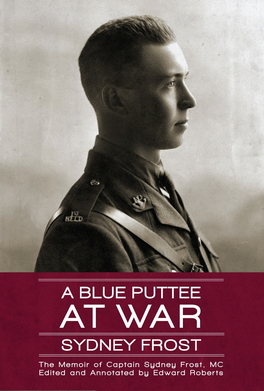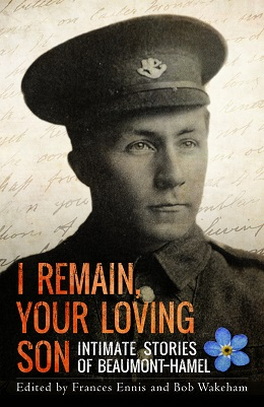This memoir is unique. It is by far the most complete account of World War I by any member of the Royal Newfoundland Regiment. Sydney Frost, a young Nova Scotian, was working in St. John’s at The Bank of Nova Scotia when the First World War began in August 1914. He joined the newly revived Newfoundland Regiment on 21 August 1914, the first night that volunteers were accepted. Assigned Regimental Number 58, he became one of the First Five Hundred, often known as the Blue Puttees. He served with the Regiment throughout the entire War, rising from the rank of Private to that of Captain. Frost was one of the few original members of the Regiment who survived to fight throughout the entire War. He was awarded the Military Cross for his heroism during the action at Keiberg Ridge, in Belgium, on 29 September 1918. Frost returned to The Bank of Nova Scotia at the end of the War and rose steadily through its ranks, retiring as President in 1958 at the age of sixty-five. He remained a Director until January 1969, when he became an Honorary Director. He died in 1985, at the age of ninety-two. Sydney Frost wrote this memoir late in life. It is frank, detailed, and authoritative, and enriched greatly by the extraordinary archive of Regimental history he assembled over his lifetime. His service in the Regiment was a central feature of his long life. He kept every scrap of paper that came his way, together with a detailed record of his daily activities between 21 August 1914 and 2 June 1919. His scrapbooks—which he later donated to the Regimental Museum in St. John’s—contain thousands of items, including newspaper cuttings and published articles of every description about the Regiment and the men with whom he served.
Excerpt from “Drie-Masten, 14 October: Thomas Ricketts wins the Victoria Cross”
I revert now to the daring exploits of Lieutenant Newman and his men in outflanking the German battery. This can best be described in the official account in The Fighting Newfoundlander:
. . . By clever manoeuvring the little party succeeded in reaching the depression south of the ridge, where they were within point-blank range of the German field guns, and under fire from the machine‑guns protecting the battery. In the platoon’s Lewis Gun detachment was a young soldier from Middle Arm, White Bay, Private Thomas Ricketts, who was only seventeen years old. Two years previously he had advanced his age to eighteen in order to join the Regiment, and he had then come over with the Windsor draft. He first saw action at the Steenbeek; and he received a bullet in the right leg at Marcoing, rejoining the Battalion in time for the fighting at Bailleul. What now took place in front of Drie‑Masten is described in the following extract from the London Gazette (6 January 1919).
Pte. Ricketts at once volunteered to go forward with his section commander [Corporal Matthew Brazil (Reg. No. 1368)] and a Lewis Gun to attempt to outflank the battery. Advancing by short rushes under heavy fire from enemy machine guns with the hostile battery, their ammunition was exhausted when still 300 yards from the battery.
The enemy, seeing an opportunity to get their field guns away, began to bring up their gun teams. Pte. Ricketts, at once realizing the situation, doubled back 100 yards under the heaviest machine‑gun fire, procured further ammunition, and dashed back again to the Lewis Gun, and by very accurate fire drove the enemy and gun teams into a farm.
His platoon then advanced without casualties, and captured the four field guns, four machine guns, and eight prisoners.
A fifth field gun was subsequently intercepted by fire and captured.
By his presence of mind in anticipating the enemy intention and his utter disregard of personal safety, Pte. Ricketts secured the further supply of ammunition which directly resulted in these important captures and undoubtedly saved many lives. (491)
His Majesty King George V honoured Ricketts with the award of the VC and later the Government of France bestowed upon him the French C de G with Golden Star. In quoting the citation as it appeared in the London Gazette, Colonel Nicholson omitted the first paragraph, which read:
For conspicuous bravery and devotion to duty on the 14th October, 1918, during the advance from Ledeghem, when the attack was temporarily held up by heavy hostile fire and the Platoon to which he belonged suffered severe casualties from the fire of a battery at point blank range.
The wording of the official citation is condensed from that submitted by me to our Adjutant on 16 October 1918, of which I still hold a copy. [The copy – in fact a carbon copy – was among the Field Messages that Frost’s children donated to Memorial University, which holds it in its Archives and Special Collections, at the Queen Elizabeth II Library.] In fact, there was a great deal of correspondence forward and back among the Royal Newfoundland Regiment, Brigade, Division, Corps, Army, GHQ, and the War Office before the authorities finally recommended to His Majesty the King that the award be granted. In retrospect, I can readily understand that my wording went into too much detail. I was inexperienced in composing recommendations for awards for bravery and now, fifty-eight years later [1976], I feel I could produce a more acceptable citation. Moreover, the circumstances under which recommendations were written could not be said to be ideal; usually in the evening by candlelight in an improvised shelter after the daily routine reports had been submitted, and often interrupted by the call of a Platoon Officer or the CSM for instructions relating to this, that and all else. No important alterations were made in my original wording – just that my story was cut for purposes of brevity.
The main reason for the exchange of correspondence was – as I was later informed – that a VC can only be awarded if two officers (apart from the one who composed the citation) certify to the correctness of the statements made. In this case the only officer of the Newfoundland Regiment who actually saw the deed performed was Lieutenant Stan Newman, apart from Second Lieutenant Taylor who was [mortally wounded] that afternoon. I did not have the nerve to call Mad Jack as a witness, although he saw part of the action from a distance. I feel sure that in many instances a way around the two witness requirement must have been found, for it is most unlikely that in every case the evidence of two officers was possible to obtain.
Many years later, I discovered that in the Ricketts case favourable intervention from an unexpected source had come to our assistance. On 23 June 1953, during a visit to Scotland on one of my business trips overseas, I was invited for lunch at the Royal Bank of Scotland Head Office, St Andrew Square, Edinburgh, friends and correspondent for many years of The Bank of Nova Scotia. It happened to be the day of a Directors’ Meeting and at lunch I met several of the Directors, a few of whom I had known before. I sat next to Sir William Darling and in the course of conversation I discovered he had been on the Staff of the Eighty-Eighth Brigade, Twenty-Ninth Division at Gallipoli and later in France an ADC to General Tudor, Commander of the Ninth Division. He remembered a great deal about the Royal Newfoundland Regiment, both when we were with the Twenty-Ninth and with the Ninth in the closing months of the War. He told me a remarkable story which went something like this: When the recommendation for Ricketts first came from Newfoundland Battalion Headquarters, it was accompanied by the verification of only one independent officer [Newman] and was returned for further evidence, which as it transpired was not available. After correspondence back and forth involving considerable delay, a message was received by Ninth Division Headquarters routed through the usual channels to the effect that the Governor of Newfoundland [Sir Charles Alexander Harris] had intervened and had strongly recommended to the War Office that a VC be awarded to Ricketts. The Governor argued that the deed as cited was worthy of the highest award and referred to the fact that no VC had been awarded to a member of the Royal Newfoundland Regiment and with the War at an end there would be no other opportunity.
A year or two after the war, General Tudor, as a representative of Holmwood & Holmwood, a salt-fish importing concern of England, was sent to Newfoundland, where he resided until his death. We entertained him at our home on Leslie Street at a bridge party one evening. When I visited St. John’s in later years, I made it a point to call on him. He presented me with two framed pictures taken in Belgium after the Armistice, one showing the King of the Belgians with his Army Staff Officers and General Tudor with his Aides, including Captain William Darling, all mounted on their steeds; the other showing General Tudor, Captain William Darling, and the Ninth Division Staff. I lodged these photographs with the Newfoundland Archives [now The Rooms Provincial Archives of Newfoundland and Labrador] a couple of years ago. General Tudor also gave me a copy of his book The Fog of War which tells of his Army experiences. Winston Churchill once said of General Tudor – “An iron peg hammered into the frozen ground – immovable.” [Tudor died in 1965 at the age of ninety-five and is buried in the Anglican cemetery on Forest Road in St. John’s.]
It was strange that the General never confided in me to the point of mentioning the intervention of the Governor in the Ricketts episode. He probably assumed I knew all about it. William Darling was knighted, served as Lord Provost of Edinburgh 1941–44, and was elected MP for South Edinburgh in 1945. He passed away at Edinburgh in 1962 at the age of seventy-six.
There have been many stories about WWI but nothing is this honest or realistic as the true tale that Frost describes. It’s hard to get inside a soldier’s head and try to imagine what they went through, during their lives and their battles but Frost gives us that possibility.-- Tint of Ink --
His memoir, a compelling and enlightening read, is Frost's last gift to the country and province and the regiment he served so well through his lifetime.-- The Telegram --
An extremely engaging work that provides tremendous insight into what military service meant in the calamitous years from 1914 through 1918.-- Newfoundland Quarterly --
An outstanding first-person narrative addition to the literature of the First World War.-- Chronicle Herald --
Frost’s tour of duty as part of the First Five Hundred is one of valour, hardship, and great loss. His account of the Great War is authoritative and detailed.-- On Track magazine --
The memoir, expertly edited and annotated by Ed Roberts, is a detailed and lively history or the Royal Newfoundland Regiment’s time in the First World War.-- Northeast Avalon Times --
A Blue Puttee at War is a great read, as well as a personal wartime account and regimental history at its very best.-- Atlantic Books Today --
A fantastic book for war fanatics, history buffs, Atlantic Canadians and those with personal connections to the Royal Newfoundland Regiment, reading Sydney Frost’s memoir should be added to your to-do list.-- Newfoundland Herald --
Edward Roberts, and the Frost family, have done us a great service in bringing us this excellent narrative. It not only adds significantly to a rich literature of soldier memoirs, but it is worth considering as a text that straddles history and memory. It also raises the issue of how little we know our way around the past, even in areas that have been well trodden.-- Newfoundland and Labrador Studies --

-249173.jpg)

















